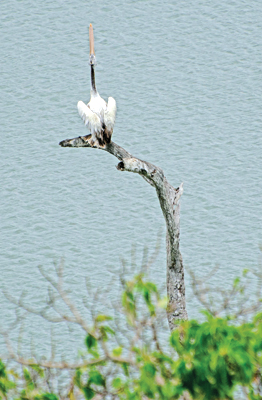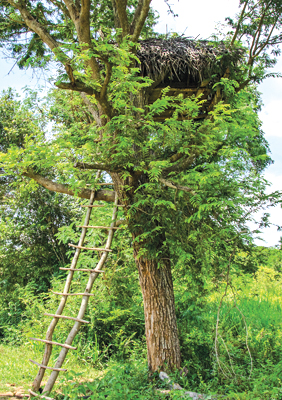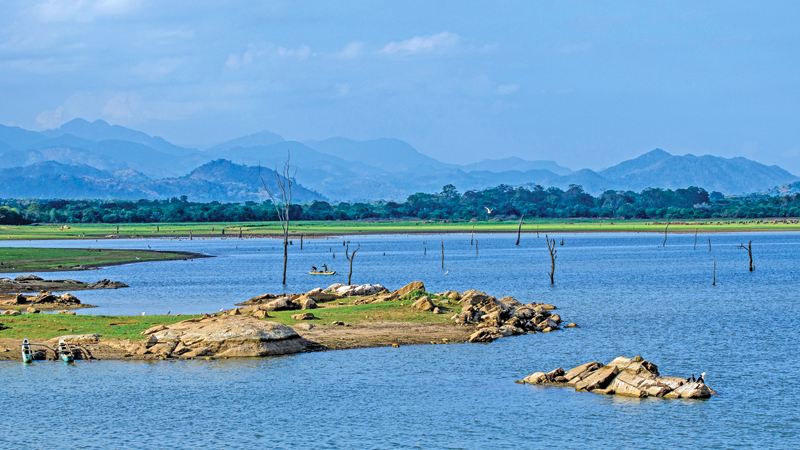 Although we had always wanted to visit the Handapanagala wewa (roughly translated as ‘rock where the moon shines’), it just did not happen, due to lack of time after my return trips from the Uva Province. However, one late afternoon on a return trip from Buduruwagala in Wellawaya, we got a chance to visit the Handapanagala wewa
Although we had always wanted to visit the Handapanagala wewa (roughly translated as ‘rock where the moon shines’), it just did not happen, due to lack of time after my return trips from the Uva Province. However, one late afternoon on a return trip from Buduruwagala in Wellawaya, we got a chance to visit the Handapanagala wewa
The Handapanagala junction is about five kilometres from the Wellawaya town, from where it is a further four kilometres to the Handapanagala wewa, which is in a breathtakingly beautiful remote setting. At the time of our visit, the tank was partially dried due to drought. One can imagine how beautiful it would be when the water level is higher.
Public attention

Cattle grazing in the catchment area in the tank while fishermen fish in the tank
Handapanagala is off the Colombo-Matara-Tissamaharama-Wellawaya main road. Public attention has been much focused through the print and electronic media from recent years on the pocketed herd of elephants wedged between the Pelawatta Sugar Plantations and the Handapanagala tank. It is the favourite watering place of these hapless herd of about 120-130 now enclaved in this settlement area.
Fed by the Kirindi Oya, which springs from the Uva hills, the Handapanagala tank is one of the most important sources of irrigation for the Uva region. The tank can serve irrigation water only for the Maha (October-December) season, and that too, only if the seasonal rains fall. Besides paddy cultivation, farmers in the surrounding areas cultivate vegetables, fruits and maize. With the setting up of the Handapanagala colonisation scheme in 1958, the whole area became developed, teeming with farmers’ settlements. Inland fishing is also a major livelihood that depends on the Handapanagala tank. From dawn to dusk, inland fishermen of Handapanagala reap a rich harvest of fish. At the time of our visit, we spotted several fishermen engaged in fishing using nets and canoes.
The Handapanagala tank nestles in a picturesque mountain frontier encompassed by a serene range of mountains that roll on and on as far as the eye could see. Vadinahela, the highest peak in the area, dominates the mountain landscape. In a distant horizon looms the awe-inspiring Poonagala mountain range which overlaps Namunukula and the far off Haputale mountain ranges, punctuated by the breathtaking Ella gap which could be prominently viewed from any elevation. Vadinahela overlooks the placid tank of Handapanagala. From the bund of the tank, one could enjoy the scenery of captivating mountains silhouetted in the distance.

A spot-billed pelican on the top of the dead tree in the tank
A memorable sight at Handapanagala is the herd of elephant that come to quench their thirst. The Handapanagala tank being a prime haunt of the roaming herd of elephants, tourists and wildlife photographers, trek to enjoy this splendid sight of elephants grazing in the catchment area of the tank and frolicking with their calves by the water’s edge.
Atop the bund of the Handapanagala tank, one could enjoy the captivating mountain scenery winding and rising over its hazy horizon. Early morning while the fishermen paddle down in their canoes along its still waters, their fascinating shadows are reflected in the glassy waters below.
Many tourists, local and foreign, hearing that the Handapanagala tank is the choicest haunt of the roaming pocketed herd of elephants, in recent years trek there to enjoy this splendid serenade of elephants, grazing in the catchment of the tank, and frolicking with their babies by the water’s edge.
The waters of the Handapanagala tank had receded in the dry season leaving stretches of parched earth and prickly shrubs that sprung from it. Boulders had also emerged from the tank bed allowing birds to catch their prey easily.
Standing on the edge of the tank bund, we listened to the loud and incessant cry of the birds which melted our fatigue away, as a gentle breeze mellowed the setting sun.
A great many varieties of birds came within our sight. A lone hawk eagle was circling high in the air and sat on the dead tree near the tank. Bemused by its unsettling cries, we looked farther away. In the distance, we saw flocks of many wading birds, busily scouring the tank bund, while a herd of free-roaming cattle were grazing near the tank bed.
We spotted a group of spot-billed pelicans huddled far away just within our sight. They appeared to be still in their vigil over the water. In the distance, mixed flocks of more wading birds came into view. These birds and their many antics could easily steal your time and we were tempted to remain in the comfort of our surroundings.
Beautiful tank
About two kilometres or so, away from the Handapanagala tank, is a small but a beautiful tank called the Pubudu wewa towards its South Eastern corner. The Pubudu wewa is another refuge for birds both local and migrant. The Handapanagala tank spilt over its spill way after 27 years, in May 1995, due to heavy rains.
Among the other birds frequenting Handapanagala are painted storks, grey herons, black winged stilts, spot-billed pelicans and hawk eagles. If you are a photographer and would like to visit the Handapanagala tank, you need DSLR camera and at least a telephoto lens range from 300mm to 600mm is a must to record these birds’ life.

A watch hut atop a tree in the Handapanagala chena cultivations
The landscape around Handapanagala is dotted with forest cover and interlaced with a stretch of teak plantation where elephants live. There are a number of medium and small mountains looming over the region. One can also find rock caves, rock pools and ancient Dagabas in ruins. Buduruwagala, the famed enchanting Mahayanist Buddhist site of rock carving lies just around seven kilometres away from the Handapanagala tank.
Rock outcrops
Another delightful landscape feature of the Handapanagala habitat, is that it is dotted with large and small rock outcrops here and there. It gives fantastic geological beauty in its natural geographical form. Perched on any of the rock outcrops whether small or big, one could have a commanding view of the whole strata of land filled with teak trees, denuded forest and the mountains rolling far, far away in the distant horizon.
Handapanagala nestles in the Ruhunu Rata and it also occupies the ancient divisions of the Dolosdas and Atadas Rata lying in the Uva-Wellassa region. Most of the archaeological sites date back to the 2nd-3rd century BC, of the regnal years of Mahanaga, Kavantissa, Dutugemunu and even later periods of the 8th-12th century AD.
Handapanagala is steeped in history and legend. The towering forest studded peak called Vadinahela, in those years of yore, had been the abode of the Yakkahas. A demon worshipping tribe, their descendants, the Veddhas are our aborigines who now face extinction. The Yakkahas are believed to have worshipped the demons who had dwelt on this mountain. Hence, in folklore it is called the hill that was being worshipped. This Vadinahela is perched in such a strategic elevation, that in one direction it appears to be looking towards Buduruwagala, a famed Mahayana Buddhist site.
It is all too easy to be mesmerised by the wildlife and the rustic, panoramic landscape of the Handapanagala wewa for hours on end. However, with a long trip ahead, we had to say goodbye, stealing only the memories that we would cherish for a lifetime.






